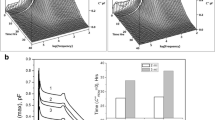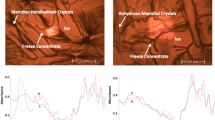Abstract
The stability of a freeze-dried model protein, ribonuclease A (RNase), was investigated under accelerated storage conditions at 45°C for time periods up to 60 days. Because RNase is a fairly stable molecule around pH 7, lyophilization was performed in phosphate buffers at pH 4.0 or 10.0 to accelerate degradation kinetics. Degradation was studied by measuring enzymatic activity, the concentrations of soluble monomeric RNase, soluble aggregated (polymerized) RNase, and insoluble aggregated RNase following reconstitution of the lyophilized material at different times. The presence of air in the vial headspace accelerated degradation in the solid state in all cases. When argon or nitrogen was employed in the headspace, degradation kinetics were reduced, implying that molecular oxygen was involved in the degradation process. This interpretation was supported by the observation that 0.05% (w/v) EDTA in the formulation prior to freeze-drying retarded RNase degradation dramatically. EDTA was believed to chelate cations which may have been introduced with the buffer salts in trace quantities sufficient to catalyze autoxidation reactions. Incorporation of antioxidants ascorbic acid (at pH 4.0) and POBN (a spin trap which could have functioned as an antioxidant at pH 10.0) accelerated the degradation of RNase and appeared, in both cases, to be involved in interactions with the protein molecules. Additionally, in the presence of the antioxidants RNase degradation appeared to be accelerated by light. Although there is strong support for the oxidative hypothesis, the possibility of other competing reactions cannot be discounted. These investigations demonstrate the importance of challenging the extrapolation of some of our well-established ideas concerning small molecule solution kinetics to macromolecules in the solid state.
Similar content being viewed by others
REFERENCES
A. M. Crestfield, W. H. Stein, and S. Moore. Arch. Biochem. Biophys., Suppl 1:217–222 (1962).
E. V. Cheever and U. J. Lewis. Endocrinology 85:465–473 (1969).
T. A. Bewley and C. H. Li. Biochemistry 11:927–931 (1972).
M. W. Townsend and P. P. DeLuca. J. Parent. Sci. Technol. 42:190–199 (1988).
T. O. Oesterling and D. E. Guttman. J. Pharm. Sci. 53:1189–1192 (1964).
M. T. Lamy-Freund, F. N. Ferreira, and S. Schreier. J. Antibiot. 38:753–757 (1985).
N. Uri. In W. O. Lundberg (ed.), Autoxidation and Antioxidants, Vol. I, John Wiley & Sons, New York, 1961, pp. 91–104.
A. Martin, J. Swarbrick, and AA. Cammarata. Physical Pharmacy, 3rd Edition, Lea & Febiger, Philadelphia, 1983, p. 385.
J. M. Gutteridge. Pharm. J. 239:401–403 (1987).
E. S. Huyser. Free Radical Chain Reactions, John Wiley & Sons, New York, 1970, pp. 8–14.
N. Uri. In W. O. Lundberg (ed.), Autoxidation and Antioxidants, Vol. I, John Wiley & Sons, New York, 1961, p. 167.
K. E. Avis. In L. Lachman, H. A. Lieberman, and J. L. Kanig (eds.), The Theory and Practice of Industrial Pharmacy, Lea & Febiger, Philadelphia, 1970, p. 567.
K. B. Chakraborty and G. Scott. J. Polymer Sci. Polymer Lett. Ed. 22:553–558 (1984).
M. Kunitz. J. Biol. Chem. 164:563–568 (1946).
O. H. Lowry, N. J. Rosebrough, A. L. Farr, and R. J. Randall. J. Biol. Chem. 193:265–275 (1951).
G. Schwarzenbach and K. Schwarzenbach. Helv. Chim. Acta 46:1390–1399 (1963).
G. Anderegg, F. L'Eplattenier, and G. Schwarzenbach. Helv. Chim. Acta 46:1400–1408 (1963).
W. P. Jencks. Catalysis in Chemistry and Enzymology, McGraw-Hill, New York, 1969, p. 133.
P. K. Nandi and D. R. Robinson. J. Am. Chem. Soc. 94:1299–1308 (1972).
P. H. von Hippel, L. Schack, and L. Karlson. Biochemistry 12:1256–1264 (1973).
A. Hamabata and P. H. von Hippel. Biochemistry 12:1264–1271 (1973).
R. A. Bradshaw, W. T. Schearer, and F. R. N. Gurd. J. Biol. Chem. 243:3817–3825 (1968).
R. A. Bradshaw and T. Peters, Jr. J. Biol. Chem. 244:5582–5589 (1969).
C. F. Shaw, III, N. A. Schaeffer, R. C. Elder, M. K. Eidness, J. M. Trooster, and G. H. M. Calis. J. Am. Chem. Soc. 106:3511–3521 (1984).
B. Halliwell and J. M. C. Gutteridge. Arch. Biochem. Biophys. 246:501–514 (1986).
N. Uri. In W. O. Lundberg (ed.), Autoxidation and Antioxidants, Vol. I, John Wiley & Sons, New York, 1961, p. 164.
L. Horner. In W. O. Lundberg (ed.), Autoxidation and Antioxidants, John Wiley & Sons, New York, 1961, pp. 210–214.
Author information
Authors and Affiliations
Rights and permissions
About this article
Cite this article
Townsend, M.W., Byron, P.R. & DeLuca, P.P. The Effects of Formulation Additives on the Degradation of Freeze-Dried Ribonuclease A. Pharm Res 7, 1086–1091 (1990). https://doi.org/10.1023/A:1015959604616
Issue Date:
DOI: https://doi.org/10.1023/A:1015959604616




